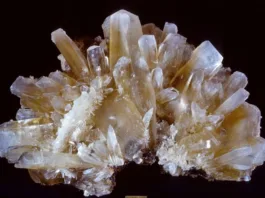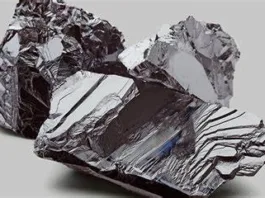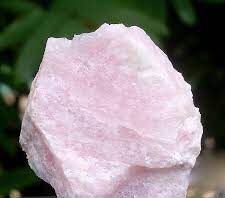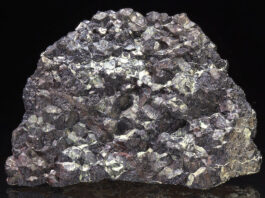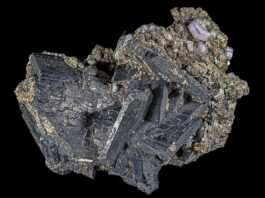Zinc ore refers to the naturally occurring rock or mineral that contains a significant concentration of zinc. Zinc is a chemical element with the symbol Zn and atomic number 30. It is a bluish-white, lustrous metal that is known for its excellent corrosion resistance, malleability, and conductivity. Zinc is an important industrial metal used in various applications, including galvanizing steel, manufacturing brass and other alloys, as well as in the production of batteries, paints, and fertilizers.
Zinc ores are typically found in association with other minerals in the Earth’s crust and are extracted through mining and processing methods to obtain zinc concentrate, which can be further processed to produce zinc metal or other zinc-containing products. The most common zinc ore minerals are sphalerite, smithsonite, hemimorphite, and zincite, which occur in different types of ore deposits, including sulfide deposits, carbonate-hosted deposits, and oxide deposits.

The mining and processing of zinc ores involve various techniques, including underground or open-pit mining, followed by crushing, grinding, and flotation or other beneficiation processes to separate the zinc minerals from the gangue minerals. The resulting zinc concentrate is then further processed through smelting or electrolysis to obtain zinc metal or other zinc-containing products.
The global zinc market is influenced by factors such as supply and demand dynamics, global economic conditions, technological advancements, environmental regulations, and geopolitical factors. Zinc is widely used in various industries, including construction, automotive, electrical and electronics, and agriculture, which drive the demand for zinc ores and zinc products.
It’s important to note that the specific geology, mineralogy, mining, and processing methods for zinc ores may vary depending on the location and type of deposit, as well as technological advancements and industry practices at a given time. Therefore, it’s always important to consult up-to-date and reliable sources for accurate and comprehensive information on zinc ore and its related topics.
Contents
Zinc Ore Minerals
Zinc ores are typically found in nature as various minerals. Some common zinc ore minerals include:
- Sphalerite: Sphalerite (ZnS) is the most important and commonly occurring zinc ore mineral. It is usually found in hydrothermal veins, as well as in sedimentary, metamorphic, and igneous rocks. Sphalerite can vary in color from yellow, brown, and black to red, green, and transparent, depending on its impurities.
- Smithsonite: Smithsonite (ZnCO3) is a secondary zinc carbonate mineral that forms from the weathering and oxidation of primary zinc sulfide minerals like sphalerite. It is typically found in oxidized zinc ore deposits and can occur in various colors, such as white, gray, green, blue, and pink.
- Hemimorphite: Hemimorphite (Zn4Si2O7(OH)2·H2O) is another secondary zinc silicate mineral that can occur in zinc ore deposits. It is typically found in oxidized zinc ore deposits and can occur in colors such as colorless, white, blue, green, and brown.
- Zincite: Zincite (ZnO) is a rare zinc oxide mineral that can occur as a primary mineral in zinc ore deposits. It is typically found in association with other zinc minerals like sphalerite and is usually red or orange in color.
- Willemite: Willemite (Zn2SiO4) is a rare zinc silicate mineral that can occur in zinc ore deposits. It is typically found in oxidized zinc ore deposits and can occur in colors such as green, yellow, and brown.
- Franklinite: Franklinite (ZnFe2O4) is a rare zinc iron oxide mineral that can occur in zinc ore deposits. It is typically found in oxidized zinc ore deposits and is usually black or dark brown in color.
These are some of the common minerals associated with zinc ore deposits. The specific mineralogy of zinc ores can vary depending on the deposit’s geology, geochemistry, and mineralization processes. Detailed mineralogical studies and analyses are typically conducted to identify and characterize the specific zinc ore minerals present in a given deposit, which can provide valuable information for exploration, mining, and processing of zinc ores.
Zinc Ore Properties
Zinc ore, also known as sphalerite (ZnS), is a mineral that typically occurs in sedimentary, igneous, and metamorphic rocks. It is the primary ore of zinc, a widely used metal with various industrial applications. Some of the key properties of zinc ore include:
- Physical properties:
- Color: Zinc ore is typically brown, yellow, or black in color, although it can also be red, green, or colorless.
- Luster: It has a resinous to adamantine luster when freshly broken, but may become dull upon exposure to air.
- Hardness: Zinc ore has a hardness of 3.5 to 4 on the Mohs scale, which means it is relatively soft and can be scratched with a knife or a fingernail.
- Density: The density of zinc ore varies depending on its composition and impurities, but typically ranges from 3.9 to 4.2 g/cm³.
- Chemical properties:
- Composition: Zinc ore is primarily composed of zinc sulfide (ZnS), but it may also contain varying amounts of other elements, such as iron, cadmium, indium, and gallium, as impurities.
- Reactivity: Zinc ore is relatively stable and does not react with air or water at normal temperatures. However, it can react with acids, producing hydrogen gas and soluble zinc salts.
- Transparency: Zinc ore is typically opaque, meaning that it does not transmit light.
- Fluorescence: Some zinc ores exhibit fluorescence under ultraviolet (UV) light, emitting a characteristic glow that can be used for identification purposes.
- Electrical properties:
- Conductivity: Zinc ore is a poor conductor of electricity, as it is an insulating mineral.
- Magnetic properties:
- Magnetism: Zinc ore is not magnetic and does not exhibit any magnetic properties.
It’s important to note that the properties of zinc ore can vary depending on the specific type of deposit, mineralogical composition, and geological conditions in which it is found. Proper identification and characterization of zinc ore properties are essential for its exploration, mining, processing, and utilization in various industrial applications.
Geology and Formation of Zinc Ore Deposits
Zinc ore deposits are formed through various geological processes and are typically associated with specific rock types, tectonic settings, and mineralization events. The geology and formation of zinc ore deposits are complex and can vary depending on the specific deposit, but generally, they are classified into two main types: sedimentary-exhalative (Sedex) deposits and Mississippi Valley-type (MVT) deposits.
- Sedimentary-exhalative (Sedex) deposits: Sedex deposits are the most common type of zinc ore deposits, accounting for a significant portion of global zinc production. They are formed in sedimentary basins through the interaction of seawater with hydrothermal fluids that are rich in zinc and other metals. These deposits are typically found in sedimentary rocks, such as shale, limestone, and dolomite, and are often associated with black shale sequences.
The formation of Sedex deposits starts with the deposition of organic-rich sediments in a basin. Over time, these sediments become buried and compacted, leading to the formation of shale or other sedimentary rocks. Hydrothermal fluids, which are rich in zinc and other metals, are then expelled from a subsurface source, such as a magma chamber or a hydrothermal vent, and migrate through the surrounding rocks. These fluids react with the organic-rich sediments, causing the deposition of zinc and other metal sulfides, such as sphalerite, in the form of stratiform layers or lenses within the sedimentary rocks.
- Mississippi Valley-type (MVT) deposits: MVT deposits are another important type of zinc ore deposits and are typically found in carbonate rocks, such as limestone and dolomite. They are formed through the interaction of hydrothermal fluids with carbonate rocks in a process known as dolomitization.
The formation of MVT deposits starts with the circulation of hydrothermal fluids, which are rich in zinc and other metals, through fractures or faults in carbonate rocks. These fluids react with the carbonate rocks, causing the replacement of calcium carbonate with zinc and other metal sulfides, such as sphalerite, in the form of vein-like structures or disseminations within the carbonate rocks.
The specific geology and formation of zinc ore deposits can vary greatly depending on the deposit’s location, age, and geological history. Factors such as tectonic setting, temperature, pressure, fluid composition, and host rock properties can all influence the formation of zinc ore deposits. Understanding the geology and formation processes of zinc ore deposits is important for the exploration, mining, and processing of zinc ores, as it can help in identifying prospective areas and developing effective extraction methods.

Exploration and Evaluation of Zinc Ore Deposits
Exploration and evaluation of zinc ore deposits involve several methods and techniques to identify and assess the potential of a deposit for economic zinc mineralization. The process typically involves the following steps:
- Geological Mapping: Detailed geological mapping of the target area is essential to understand the geology and structure of the rocks hosting the potential zinc ore deposit. This includes mapping of rock types, structures (such as faults, fractures, and folds), alteration zones, and other geological features that may indicate the presence of zinc mineralization.
- Geochemical Sampling: Geochemical sampling involves collecting and analyzing rock, soil, and water samples to determine the presence of zinc and other elements associated with zinc mineralization. Various methods, such as stream sediment sampling, soil sampling, and rock chip sampling, may be used to collect samples from the target area. These samples are then analyzed in the laboratory to determine their zinc content and other geochemical signatures that may indicate the presence of zinc ore deposits.
- Geophysical Surveys: Geophysical surveys are used to detect subsurface anomalies that may indicate the presence of zinc mineralization. Common geophysical methods used for zinc exploration include magnetic surveys, gravity surveys, electromagnetic surveys, and induced polarization (IP) surveys. These methods can help identify the distribution and extent of potential zinc ore deposits based on the differences in physical properties of the host rocks and mineralized zones.
- Drilling: Once preliminary exploration methods indicate the potential for zinc mineralization, drilling is often conducted to obtain core samples from the subsurface. Diamond drilling is commonly used in zinc exploration to obtain core samples that provide detailed information about the composition, structure, and mineralization of the rocks. The core samples are analyzed in the laboratory for zinc content, mineralogy, and other geological information.
- Resource Estimation: Based on the results of geological mapping, geochemical sampling, geophysical surveys, and drilling, a resource estimation is conducted to estimate the size and grade of the potential zinc ore deposit. This involves calculating the volume and grade of the mineralized zone using various mathematical and statistical methods, and may involve creating 3D models of the deposit.
- Economic Evaluation: Economic evaluation of a zinc ore deposit involves assessing the economic viability of mining and processing the deposit. This includes estimating the potential zinc reserves, evaluating the mining and processing costs, considering the commodity price of zinc, and conducting financial analyses to determine the potential profitability of the project.
- Environmental and Social Assessment: Alongside the technical and economic evaluation, an assessment of the environmental and social impacts of the proposed mining and processing operations is also conducted. This involves evaluating potential environmental impacts, social and community considerations, and regulatory compliance to ensure that the project is environmentally and socially responsible.
Exploration and evaluation of zinc ore deposits require a multidisciplinary approach involving geology, geochemistry, geophysics, drilling, resource estimation, economic evaluation, and environmental and social assessment. It is essential to follow industry best practices and comply with local regulations and standards during the exploration and evaluation process.
Mining and Processing of Zinc Ores
Mining and processing of zinc ores involve several stages, including extraction, beneficiation, and smelting. Here is a general outline of the process:
- Exploration and Mine Development: Once a potential zinc deposit has been identified through exploration methods, and its economic viability has been established through resource estimation and economic evaluation, mine development activities commence. This includes acquiring necessary permits, conducting detailed geological and geotechnical studies, constructing access roads, and developing infrastructure such as mine shafts, tunnels, and processing facilities.
- Extraction: Zinc ore is typically extracted from underground mines using various methods, including open-stope mining, room and pillar mining, and cut-and-fill mining. Underground mining methods depend on the geology and structure of the deposit, as well as the size and shape of the ore body. The ore is extracted from the mine using drilling and blasting, and then transported to the surface for further processing.
- Beneficiation: Once the ore has been extracted from the mine, it is typically subjected to beneficiation processes to separate the valuable zinc minerals from the gangue (non-valuable) minerals. Beneficiation may involve crushing, grinding, screening, gravity separation, flotation, and other methods to concentrate the zinc minerals and remove impurities.
- Smelting: After beneficiation, the concentrated zinc ore is then smelted in a furnace to produce zinc metal. Smelting involves heating the ore to high temperatures (typically around 1200-1300°C) in the presence of a reducing agent, such as carbon or carbon monoxide, to reduce the zinc minerals to metallic zinc. The resulting liquid zinc is then cast into ingots or other forms for further processing.
- Refining: The zinc metal obtained from smelting may undergo further refining processes to remove impurities and achieve the desired purity. This may involve processes such as electrolysis, distillation, and other refining methods to produce high-quality zinc metal that meets the required specifications for various industrial applications.
- Environmental and Social Considerations: Mining and processing of zinc ores often have environmental and social impacts that need to be addressed. This includes managing waste rock, tailings, and other mining-related residues, mitigating potential environmental pollution, addressing water and air quality concerns, and complying with relevant environmental and social regulations. It is important for mining and processing operations to adhere to best practices and follow strict environmental and social standards to ensure responsible and sustainable operations.
- Product Distribution: Once the zinc metal has been refined, it is typically sold to various customers, including manufacturers of galvanized steel, brass and bronze alloys, batteries, and other zinc-based products. The distribution of zinc metal may involve transportation by rail, road, or sea to reach the end users.
Mining and processing of zinc ores involve complex and specialized processes that require careful planning, engineering, and environmental and social considerations. It is essential to follow industry best practices, comply with local regulations, and implement sustainable mining and processing practices to minimize the environmental and social impacts associated with zinc production.
Uses of Zinc and Zinc Products
Zinc is a versatile metal with a wide range of uses and applications across various industries. Some of the major uses of zinc and zinc products include:
- Galvanizing: Zinc is commonly used for galvanizing steel and iron to protect them from corrosion. Zinc-coated steel is widely used in construction, automotive, and other industries due to its excellent corrosion resistance and durability.
- Alloying: Zinc is used as an alloying element in the production of brass, which is a copper-zinc alloy, and bronze, which is a copper-tin-zinc alloy. Brass and bronze alloys are used in a wide range of applications, including plumbing fixtures, electrical components, musical instruments, and decorative items.
- Batteries: Zinc is used in the production of zinc-carbon and zinc-nickel batteries, which are commonly used in household appliances, toys, flashlights, and other applications.
- Chemicals: Zinc is used as a raw material in the production of various chemicals, such as zinc oxide, zinc sulfate, and zinc chloride. These chemicals are used in industries such as rubber, paint, ceramics, and agriculture.
- Dietary Supplements: Zinc is an essential mineral for human health, and zinc supplements are commonly used to address zinc deficiencies and promote overall health.
- Anti-Corrosion Coatings: Zinc-rich coatings are used for anti-corrosion protection in marine and industrial environments, such as offshore structures, pipelines, and bridges.
- Pharmaceutical and Health Products: Zinc compounds are used in the production of pharmaceuticals and health products, including ointments, creams, lozenges, and dietary supplements, due to their antimicrobial properties.
- Zinc Die Casting: Zinc’s low melting point and good casting properties make it suitable for die casting applications, where complex shapes and fine details are required. Zinc die castings are used in automotive parts, household appliances, and other products.
- Agricultural Applications: Zinc is used as a nutrient in fertilizers to improve crop growth and yield in zinc-deficient soils.
- Other Applications: Zinc is used in various other applications, such as in the production of paints, pigments, rubber, ceramics, and as a component in some types of fireworks.
The uses of zinc and zinc products are diverse and widespread, making zinc an important and valuable metal in many industries and applications.

Occurrence and distribution of zinc ores worldwide
The occurrence and distribution of zinc ores worldwide can vary depending on geological, geochemical, and economic factors. However, zinc ores are found in many countries across different continents. Here is a general overview of the occurrence and distribution of zinc ores worldwide:
- North America:
- Canada: Canada is one of the largest producers of zinc ores in the world, with significant deposits located in the provinces of British Columbia, Yukon, and Nunavut.
- United States: Zinc ores are found in several states in the United States, including Alaska, Idaho, Missouri, and Tennessee.
- South America:
- Peru: Peru is a significant producer of zinc ores, with major deposits located in the central Andes Mountains, particularly in the regions of Pasco, Ancash, and Lima.
- Bolivia: Bolivia is known for its zinc deposits, particularly in the Cerro Rico de Potosi region.
- Europe:
- Ireland: Ireland has a long history of zinc mining, with significant deposits located in the counties of Tipperary, Galway, and Wexford.
- Poland: Poland is a major producer of zinc ores in Europe, with significant deposits located in the Upper Silesia region.
- Kazakhstan: Kazakhstan has significant zinc deposits in the regions of Karaganda and Aktobe.
- Asia:
- China: China is the largest producer of zinc ores in the world, with deposits located in various provinces, including Inner Mongolia, Xinjiang, and Yunnan.
- Australia: Australia is a major producer of zinc ores, with significant deposits located in the states of Queensland, New South Wales, and Western Australia.
- India: India has zinc ore deposits in the states of Rajasthan and Andhra Pradesh.
- Africa:
- Namibia: Namibia is a significant producer of zinc ores, with deposits located in the Rosh Pinah region.
- South Africa: South Africa has zinc deposits in the Northern Cape and Limpopo provinces.
- Other regions:
- Russia: Russia has zinc deposits in various regions, including the Urals, Siberia, and the Caucasus.
- Mexico: Mexico is known for its zinc ores, with significant deposits located in the states of Zacatecas, Chihuahua, and Durango.
It’s important to note that the occurrence and distribution of zinc ores can change over time due to exploration, mining, and economic factors. Additionally, the quality and quantity of zinc ores can vary depending on the specific deposit and its geological characteristics. Therefore, up-to-date and reliable sources of information, such as geological surveys, mining reports, and industry publications, should be consulted for accurate and current information on the occurrence and distribution of zinc ores worldwide.
Future Trends and Challenges in Zinc Ore Industry
The zinc ore industry, like any other industry, is influenced by various trends and faces challenges that may shape its future. Some of the potential future trends and challenges in the zinc ore industry include:
- Technological advancements: Advancements in mining and processing technologies can lead to more efficient extraction and processing of zinc ores, resulting in increased productivity and cost reduction. Emerging technologies such as automation, remote sensing, and digitalization can also improve safety and environmental performance in the industry.
- Environmental regulations and sustainability concerns: Stricter environmental regulations and increasing awareness of sustainability and environmental issues may pose challenges for the zinc ore industry. Compliance with environmental regulations, such as air and water quality standards, waste management, and reclamation requirements, can increase costs and impact operations. There may also be growing demand for sustainable mining practices, including responsible resource extraction, biodiversity conservation, and community engagement.
- Economic and market factors: Economic factors, such as changes in global demand for zinc, commodity prices, and currency fluctuations, can significantly impact the zinc ore industry. Shifts in market dynamics, including changes in supply and demand patterns, trade policies, and geopolitical factors, may affect the availability and pricing of zinc ores in the global market.
- Social and community considerations: The zinc ore industry may face social and community challenges related to land access, indigenous rights, social license to operate, and stakeholder engagement. Ensuring effective communication, engagement, and collaboration with local communities, indigenous peoples, and other stakeholders can be critical for successful operations and sustainable development.
- Energy and climate-related concerns: As the world transitions to a low-carbon economy, energy and climate-related concerns may impact the zinc ore industry. Changes in energy prices, availability, and regulations, as well as carbon pricing mechanisms, may influence the cost of production, transportation, and processing of zinc ores. There may also be increasing demand for low-carbon zinc production technologies, such as renewable energy-powered operations and carbon capture, utilization, and storage (CCUS) solutions.
- Supply chain management: Managing complex and global supply chains for zinc ores, including transportation, logistics, and trade regulations, can be a challenge for the industry. Ensuring secure and reliable access to zinc ore deposits, as well as managing risks associated with supply chain disruptions, market volatility, and geopolitical tensions, can impact the industry’s operations and competitiveness.
- Health and safety considerations: Health and safety of workers in the zinc ore industry is of paramount importance. Ensuring compliance with occupational health and safety regulations, implementing effective safety measures, and promoting a culture of safety can be ongoing challenges for the industry.
- Innovation and diversification: Encouraging innovation, diversification, and value-added utilization of zinc ores can drive the growth and competitiveness of the industry. Exploring new markets, applications, and product developments, such as zinc recycling, advanced materials, and emerging technologies, can create new opportunities and challenges for the zinc ore industry.
Overall, the future of the zinc ore industry will likely be shaped by a combination of technological advancements, environmental regulations, economic and market factors, social considerations, energy and climate-related concerns, supply chain management, health and safety considerations, and innovation and diversification efforts. Addressing these trends and challenges proactively and responsibly can help ensure the sustainability and success of the zinc ore industry in the future.


